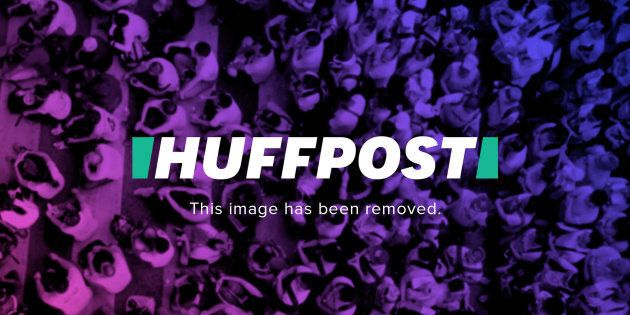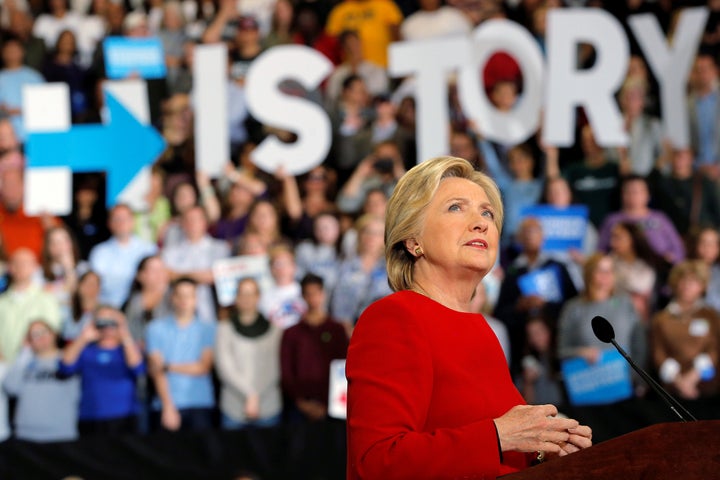

In a private conference call with top campaign surrogates just days after the election, several high-ranking Hillary Clinton campaign officials offered an overview of how, exactly, they came up short against Donald Trump.
It fell on Navin Nayak, the campaign’s director of opinion research, to offer the statistical explanation. Nayak, whose role in the presidential campaign had gone almost entirely unnoticed until after its unravelling, noted that in the closing weeks before the election, internal models had both Trump and Clinton losing roughly the same percentage of the vote to third-party candidates Jill Stein and Gary Johnson. All of Stein’s support was coming from Clinton’s camp, while Johnson was taking more from Trump but a little from Clinton too, he explained. But when the final data came in, the campaign was shocked by how far off its assumptions had been.
“People who were unfavorable to both candidates, instead of breaking evenly as we thought, overwhelmingly voted for Donald Trump by a 20 to 30 percent margin,” Nayak said, according to notes taken by the attendee.
Senior campaign adviser Jennifer Palmieri jumped in with an assessment that was, by that point, redundant: “There seemed to be a bit of a secret Trump vote.”
It has been almost two weeks since that call. But the dispute over why so many late deciders went to Trump over Clinton remains unresolved within the Clinton campaign and the Democratic Party writ large. Its answer could play a dramatic role in the trajectory taken by the party in the Trump administration era, informing everything from party messaging to campaign tactics.
Speaking after Nayak, both Palmieri and campaign chairman John Podesta offered their own explanations. Podesta placed blame on FBI Director James Comey for re-launching an ultimately fruitless investigation into Clinton’s emails just days before the vote. Palmieri, meanwhile, pushed back on criticism that Clinton wasn’t enough of a progressive-populist, that Sen. Bernie Sanders (I-Vt.) would have won had he been the nominee, noting that Clinton did better in Wisconsin than former Sen. Russ Feingold (D-Wis.), an unimpeachable liberal firebrand. Both criticized the proportionality of the media coverage of Clinton-related controversies to those surrounding Trump.
Outside of leadership circles, however, a different type of explanation has been considered, one that places more blame on strategic calculations than external factors. Officials who worked in various battleground states say the campaign erred in its belief that modern technology could fully replace traditional pavement-pounding, that Clinton didn’t need to score major victories with on-the-fence voters if she could turn out the committed.
“This whole narrative that they didn’t do a good enough job talking to undecided voters in blue collar areas and exurbs is wrong,” said a senior battleground state operative. “They didn’t do talking. They had this strategic decision that voter registration was a better use of their time than persuasion. It was a bullshit false choice.”
In the course of an election, a campaign performs three basic functions in order to win votes, which, in the end, is the fundamental goal in a democratic system of governance. The first is registration: the act of getting individuals able to cast votes. The second is persuasion: the act of trying to convince people that you deserve their vote. And the third is get out the vote (GOTV): the act of getting people to actually vote.
Different campaigns place different emphases on each of these functions depending on the electorate and election. For the Clinton campaign, emphasis was placed on the first and the third. Part of it was sober-minded calculation. Traditional persuasion is, in many regards, viewed as antiquated, something candidates did before the internet liberated them to have countless more conversations with voters at a fraction of the cost. Certainly, data show that it can require a large investment of resources with little payoff. But part of it was also a sense that in a contest between two universally known candidates, it would be difficult to change people’s minds, to actually persuade them.
The Clinton campaign still tried. It modeled voters based on their risk aversion and desire to change political leadership. It pinpointed messages to persuade Stein supporters to vote Democratic and scored how undecideds could be moved based on specific issues delivered over specific mediums (TV, mail, digital and so on). The result allowed the campaign to pinpoint voters with helpful specificity. For example, the campaign concluded that white working-class men with daughters were more likely to vote for Clinton if they saw language Trump used to describe women than by straightforward economic messaging.
But the campaign didn’t put much human capital behind persuasion save for in specific states with a large population of independent voters, like New Hampshire, where the campaign’s state director, Mike Vlacich, said they started in late spring 2016. It did not have canvassing operations up and running over the summer months in places like Florida and Michigan. And when it did have volunteers and canvassers fan out, they were sent to take advantage of early voting deadlines.
At the state and county level, this left operatives worried that they were both leaving potential votes unattended and relying way too heavily on getting their own people to the polls. Their margin for error, in other words, was being self-limited.
One operative who volunteered with the group Jewish Women for Hillary noted that members kept asking for scripts to make persuasion calls only to be instructed to do ballot collection and other GOTV activities
“The undecided voters were being left to their own devices,” the operative said. “And in that instance, if no one has reached out with a personal touch or the candidate hasn’t shown up, well, when all that bad information comes their way and momentum is so on the side of change, there is nothing to stop that wave.”
One campaign organizer in the Midwest said that canvassers were told not to leave literature on doors because it wasn’t statistically persuasive. (The “pledge to vote” cards they brought with them were brought back to the campaign offices for GOTV.)
“It was a national decision based on data,” the organizer said. “Everyone knew who she was and he was, so there wasn’t any statistical reason to persuade people. The only way to make a difference was to add people to the rolls through voter registration.”
A similar situation was recounted by two operatives who worked with the Clinton campaign in Florida. Each said that the time and human capital put behind persuasion was pinched when headquarters in Brooklyn, New York, directed them to extend their voter register efforts.The assumption, said one of the organizers, was Clinton would win the state if she could reconstruct the coalition President Barack Obama had put together and benefit from the natural diversification of the state’s population.
It wasn’t a terrible bet to make, said Steve Schale, who ran Obama’s two campaigns in Florida. But it also meant that Clinton would be banking heavily on strong Democratic turnout.
“My sense of it was they took an approach that if we draw a circle around Miami and run up record numbers, and if everything else stays the same, we should win. Which is right,” said Schale. “But my global take of the state is it is not a turnout or persuasion state. There are people who think it is a turnout state: If you hit your numbers you will win. My view is that if both parties hit their numbers you will both get to 47 percent. It is never not persuasion. You have to do persuasion and turnout.”
Clinton will end up winning the popular vote in the 2016 election and by a fairly sizable margin. But elections in America aren’t democratic on a national scale. They require a candidate to cobble together enough state Electoral College votes to win. And in a number of key battleground states, Clinton was undone by the 20 percent to 30 percent of the late deciders who unexpectedly turned to Trump.
For those operatives who worked in those states, it is clearer now than it was even during the campaign that they should have buffered themselves against that potential wave. Investments that were made in Arizona and the Omaha market (where one Electoral College vote was at play) seem particularly questionable in light of the frustratingly close margins in Wisconsin, Michigan and Pennsylvania.
“They were overextended,” said the senior battleground state operative.
But for the top ranks of the Clinton campaign, the failure is not so much about poor decisions as it is about poor data. Their models showed that the best way to defeat Trump was to paint him as unqualified for the office of the presidency, which they successfully did. Voters just ended up not caring. As one top official asked: When your own polling shows you are likely to win and the public polling says the same, “what would you have done differently?”
The next Democratic presidential nominee will have to tackle that question and, by extension, the question of whether Clinton’s failure was a sui generis byproduct of the current climate or a strategic misstep by her campaign. He or she will also be left to decide to what extent campaigns can work off of hard data and statistical models and how much the old ways should be reintroduced into strategic considerations.
“Sometimes I worry, as we’ve embraced more of the science of politics and less of the art, we draw boxes around people and have algorithms for determining how they will vote,” said Schale. “In reality, I’m not sure it is the most efficient way to win.”